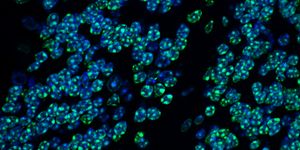A Human Enzyme That Originated in a Single-Celled Organism
The tree of life has three branches: archaea, bacteria, and eukaryotes. Eukaryotes include complex organisms, including plants, animals, and fungi. Eukaryotic cells contain many organelles, little molecular machines that serve special roles, and are bound by a membrane. Eukaryotic cells evolved from simpler cells, like bacteria and archaea. The Asgard archaeal phylum is currently thought to be eukaryotes' closest known ancestor. Now researchers have found an enzyme in humans cells that may have evolved from archaea; a form of it was found in a single-celled archeal organism. This enzyme has special characteristics that could help improve the design of novel enzymes. The findings have been reported in Science Advances.
"The discovery adds a small piece of the puzzle to understanding how human cells have evolved from more primitive predecessors. The timing is interesting given that the Nobel Prize in Physiology or Medicine went to the great discovery that we humans have a lot of Neanderthal DNA in our genetic material," said senior study author Magnus Wolf-Watz, a professor at Umeå University.
This work focused on an enzyme found in human cells, called AK6. This enzyme is found in the nucleus, and has functions in a variety of processes, including metabolism, stabilization of the genome, and a process that helps dispose of damaged or unhealthy cells called programmed cell death.
In this study, the researchers used nuclear magnetic resonance and crystallography techniques to trace features of this enzyme back to an archaea called Odinarchaeota.
Some things about Odinarchaeota are different from AK6. For example, AK6 will recognize and act with one particular molecule to catalyze a biochemical reaction, while the parallel enzyme found in Odinarchaeota can use different molecules when catalyzing reactions.
The researchers also revealed the mechanism that underlies the archaeal enzyme, and allows it to have broad efficacy, noted Professor Elisabet Sauer-Eriksson, a professor at Umeå University. "The trick is that the enzyme from Odinarchaeota uses the amino acid glutamine, which has unique chemical properties that are used to their full potential in the enzyme. The general and broad recognition of different molecules takes place with a short loop sequence in the enzyme and this loop could be used as a Lego piece in the design of new enzymes."
This work could help provide insight into the development of enzymes that could be used in environmentally conscious efforts, such as processing wood materials, for example.
Sources: Umea University, Science Advances









